
The Eifel is a low mountain range in western Germany, eastern Belgium and northern Luxembourg. It occupies parts of southwestern North Rhine-Westphalia, northwestern Rhineland-Palatinate and the southern area of the German-speaking Community of Belgium.
Vulkaneifel is a district (Kreis) in the northwest of the state Rhineland-Palatinate, Germany. It is the least densely populated district in the state and the fourth most sparsely populated district in Germany. The administrative centre of the district is in Daun. Neighboring districts are Euskirchen, Ahrweiler, Mayen-Koblenz, Cochem-Zell, Bernkastel-Wittlich, and Bitburg-Prüm.

A maar is a broad, low-relief volcanic crater caused by a phreatomagmatic eruption. A maar characteristically fills with water to form a relatively shallow crater lake, which may also be called a maar.

Daun is a town in the Vulkaneifel district in Rhineland-Palatinate, Germany. It is the district seat and also the seat of the Verbandsgemeinde of Daun.

Manderscheid is a town in the Bernkastel-Wittlich district in Rhineland-Palatinate, Germany, and also both a climatic spa and a Kneipp spa. Until 1 July 2014, when it became part of the Verbandsgemeinde Wittlich-Land, it was the seat of the former Verbandsgemeinde Manderscheid.

The House of Manderscheid was the name of the most powerful family in the Eifel region of Germany for a considerable period of time in the 15th century. In 1457, Dietrich III von Manderscheid was made a Reichsgraf by the Emperor. When Dietrich died on 20 February 1498, he had appointed his sons Johann, Konrad and Wilhelm as new rulers – the family property had been distributed in 1488. Each of the sons founded a powerful lineage: Johann started the Manderscheid-Blankenheim-Gerolstein line, William the Manderscheid-Kail line, and Konrad (Cuno) the Manderscheid-Schleiden line. Augusta von Manderscheid-Blankenheim was the last countess. She was married to a member of the Bohemian nobility, Count Philipp Christian von Sternberg (1732–1811).

Himmerod Abbey was a Cistercian monastery in the community of Großlittgen in the Verbandsgemeinde of Manderscheid in the district of Bernkastel-Wittlich, Rhineland-Palatinate, Germany, located in the Eifel, in the valley of the Salm.

Niederöfflingen is an Ortsgemeinde – a municipality belonging to a Verbandsgemeinde, a kind of collective municipality – in the Bernkastel-Wittlich district in Rhineland-Palatinate, Germany.

Bleckhausen is an Ortsgemeinde – a municipality belonging to a Verbandsgemeinde, a kind of collective municipality – in the Vulkaneifel district in Rhineland-Palatinate, Germany. It belongs to the Verbandsgemeinde of Daun, whose seat is in the like-named town.
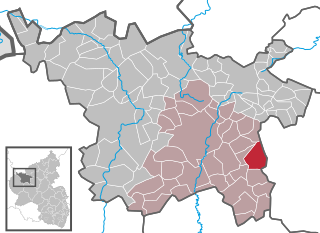
Demerath is an Ortsgemeinde – a municipality belonging to a Verbandsgemeinde, a kind of collective municipality – in the Vulkaneifel district in Rhineland-Palatinate, Germany. It belongs to the Verbandsgemeinde of Daun, whose seat is in the like-named town.

Duppach is an Ortsgemeinde, part of a group of municipalities called the Verbandsgemeinde of Gerolstein, which is located in the town of Gerolstein in the Vulkaneifel district of the state of Rhineland-Palatinate, Germany.
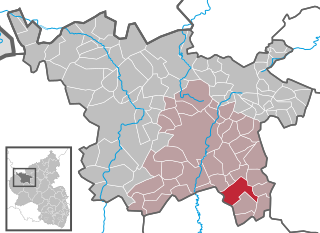
Gillenfeld is an Ortsgemeinde – a municipality belonging to a Verbandsgemeinde, a kind of collective municipality – in the Vulkaneifel district in Rhineland-Palatinate, Germany. It belongs to the Verbandsgemeinde of Daun, whose seat is in the like-named town.

Steffeln is an Ortsgemeinde – a municipality belonging to a Verbandsgemeinde, a kind of collective municipality – in the Vulkaneifel district in Rhineland-Palatinate, Germany. It belongs to the Verbandsgemeinde of Gerolstein, whose seat is in the municipality of Gerolstein.

The Volcanic Eifel or Vulkan Eifel, also known as the East Eifel Volcanic Field (EEVF), is a region in the Eifel Mountains in Germany that is defined to a large extent by its volcanic geological history. Characteristic of this volcanic field are its typical explosion crater lakes or maars, and numerous other signs of volcanic activity such as volcanic tuffs, lava streams and volcanic craters like the Laacher See. The Volcanic Eifel is still volcanically active today. One sign of this activity is the escaping gases in the Laacher See.

The Volcano Park in Mayen-Koblenz is a geopark in the rural district of Mayen-Koblenz in the eastern Vulkan Eifel, Germany. It was founded in 1996 and wraps around the Laacher See. Together with the Volcano Park, Brohltal/Laacher See and the Vulkan Eifel Nature and Geo-Park, it forms part of the national Eifel Volcano Land Geo-Park. The three parks are connected by the 280-kilometre-long German Volcano Route.
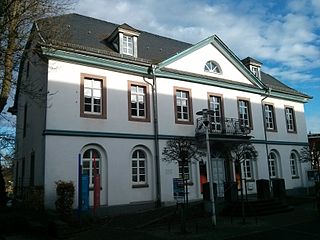
The Volcano Museum in the old district administrative office (Landratsamt) in Daun, Germany, was set up as an extension of the existing 'geopaths' at Hillesheim, Manderscheid and Gerolstein and is part of the Volcanic Eifel Nature and Geopark.
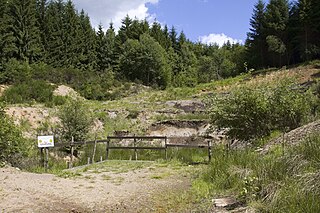
The Eckfelder Maar is a former volcanic lake, that was formed during the Middle Eocene around 44.3 million years ago and is thus the oldest known maar. It lies in the southwestern Eifel mountains near Manderscheid in Germany. It is also an important fossil site that contains numerous fossil remains of fauna and flora, some of them nearly complete state of preservation. It has been continuously scientifically researched since 1987. The large number of finds - to date 25,000 fossil specimens have been found - have enabled a very detailed reconstruction of the landscape. This maar, a low volcanic crater, along with research areas at the Grube Messel and the Geiseltal valley, is one of the foremost palaeontological sites for this geological epoch in Central Europe and worldwide.
The German Wildlife Route runs through the Eifel mountains.
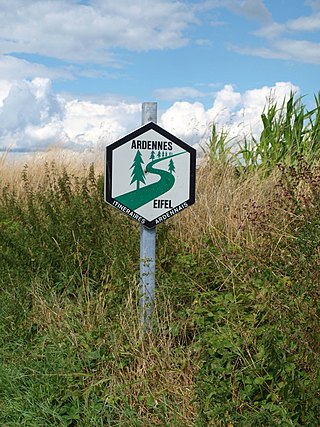
The Eifel-Ardennes Green Route or Eifel-Ardennes Green Road is a cross-border, tourist route, about 500 kilometres long, which links the Ardennes to the Eifel. It runs from France via Belgium and Luxembourg to Germany mainly on quiet by-ways.

The Meerfelder Maar is a maar by the village of Meerfeld not far from the town of Manderscheid in the Eifel in the German state of Rhineland-Palatinate.


















